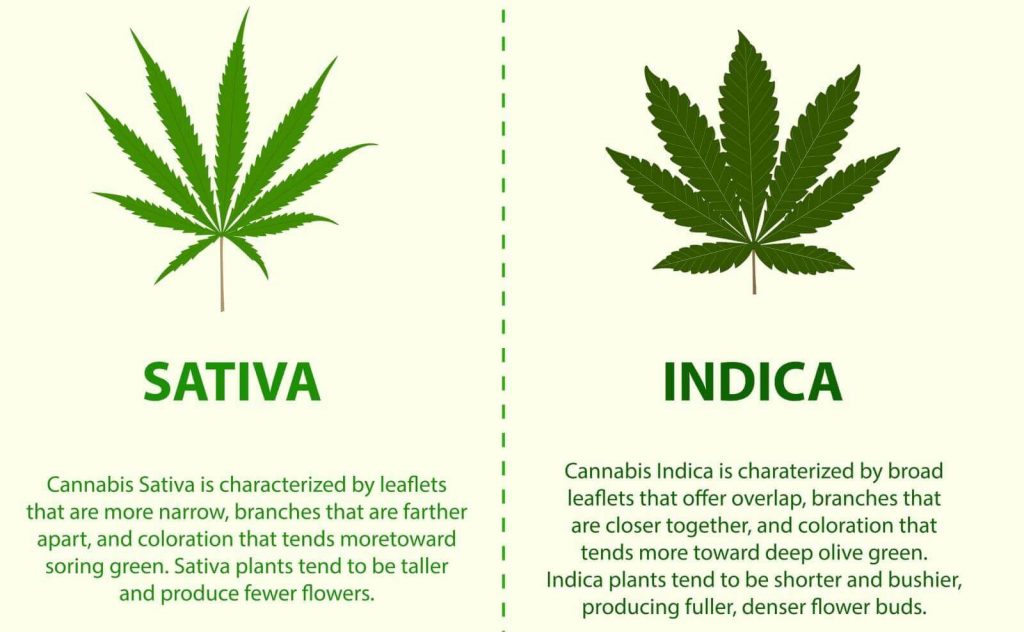Even if you’re a newbie to the world of cannabis terminology, you may have heard the terms “indica” and “sativa.” If you’re a moderate or veteran user, you’re likely well familiar with these terms.
Both sativa and indica strains are used for a number of medicinal and recreational purposes. In general, the common thought and one that satisfies many users is that …
- Sativas are known for their “head high,” and providing an invigorating and energizing effect that can help reduce anxiety or stress while increasing creativity and focus.
- Indica strains are typically associated with full-body effects, such as increasing deep relaxation and reducing insomnia.
BUT, some studies have shown that sativa doesn’t always help you focus and that some indicas will get you hyped and the reason is terpenes. While indica and sativa are easy ways to classify weed strains, the terpene profile of a plant will really tell you what will happen to your body when you get high. Read more about what terpenes are or learn more about the different types of terpenes and what they do and how they impact the mental and physical effects.
But for now, let’s focus on the difference between indica and sativa cannabis strains.

What’s in the Name?
But do the terms accurately describe the plant? Are the terms important in indicating results? Can someone rely solely on the label “indica” or “sativa” to determine what their experience will be when using one or the other? Experts say it’s not that simple.
Individual cannabis plants produce varying effects, even among the same types; it all depends on each plant’s chemical composition and the growing technique used.
To get more detailed, often the various plant types are broken down into specific strains which are differentiated by their individual cannabinoid and terpene content. The cannabis plant’s compounds are what determine a strain’s overall effects.
Cannabis plants contain dozens of naturally occurring chemical compounds called cannabinoids that are responsible for producing both negative and positive effects. Quite frankly, researchers still don’t understand what all of the cannabinoids do, but two main ones have been identified: tetrahydrocannabinol (THC) and cannabidiol (CBD), along with several less common compounds.
What to Look For
From a physical standpoint, there are some visual differences between sativa and indica plants. Because most strains available today are hybrids, it can be hard to tell from dried herb what is indica versus sativa. But there are still a few guidelines that can point you toward making an educated guess.
Sativa
Sativa plants have longer flowering cycles, fare better in warm and more humid climates with long seasons, and usually grow taller with light-green, narrow leaves. Sativa plants will have more slender leaves and grow tall as means of preventing the appearance of mold. The height change is more noticeable during the flowering stage; with the right outdoor conditions, these plants can grow up to 18 feet tall!
When you’re looking at a bag of buds and it appears as though you’ve been given more than you paid for, you’re probably handling sativa. Sativa buds are wispier and less dense, so the volume looks like more.
Indica
Indica plants tend to be shorter with thick stems and broad, deep-green leaves. They also have short flowering cycles, and grow sufficiently in cold, short-season climates. Their leaves are broader and thicker so that sunlight is more easily caught. They have shorter flowering periods to avoid mold during the fall.
Indica buds look more aesthetic, with heavier and denser buds than sativas. These are what a lot of consumers look for. They grow in dense clusters closer to the nodes, creating the classic “crunchy” look. This look created a trend in the market. Today, pure sativa plants are rare, not only because of their growing requirements, but also because of bud appearance.
However, the differences between indicas and sativas aren’t as clear-cut as people have commonly believed, some experts say, and certainly how the plant “looks” isn’t indicative of result. Many now argue that a better metric for consumers would be to look at the different cannabinoid and terpene compositions within the plant, as these factors will give users far greater insight into the effects of that particular plant.
Then How to Choose?
So how can we predict what kind of chemical properties a strain has — and therefore what kind of effects it could produce?
A great deal of attention is paid to the amount of THC and CBD in a given strain, but newer research suggests that terpenes may be just as impactful. Terpenes are a naturally occurring compound in the cannabis plant — essentially, the plant’s essential oils. Terpenes are responsible for the plant/bud’s smell and because they contain their own properties and effects, the terpene compounds present in a particular plant will and can directly affect the experience. They certainly may also influence the effects produced by specific strains.
Experts recommend using a source that is backed by lab testing. Testing can assess the levels of THC, CBD, and other cannabinoids and components, like terpenes. Know your source and always look at labels — including the lab testing data — when you’re at the dispensary. And ask questions if you need clarification. Just know that “indica” or “sativa,” aren’t the only two factors to consider when choosing your cannabis, and in fact, may not be the most important factor at all.
